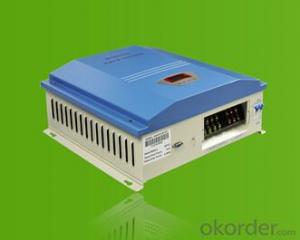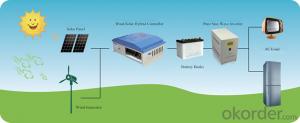Wind Solar Hybrid Controller 1KW-48VPWM Stepless Unload Mode
- Loading Port:
- Shanghai
- Payment Terms:
- TT or LC
- Min Order Qty:
- 1 unit
- Supply Capability:
- 5000 unit/month
OKorder Service Pledge
OKorder Financial Service
You Might Also Like
I. PRODUCT INTRODUCTION
The wind/solar hybrid controller is the control device which can control wind turbine and solar panel at the same time and transform wind and solar energy into electricity then stores to the battery bank.Wind/solar hybrid controller is the most important part in off-grid system, whose performance has much effect on life expectancy and operational stability of the whole system, especially the battery expectancy. Or battery service life will be shortened by over-charge or over-discharge.
II. PERFORMANCE FEATURES
Superior military-grade components to ensure the product stability.
Perfect protection function, thus the system has higher reliability.
Check and set all operation parameters as requirement from LCD display.
Voltage limiting and current-limiting charge mode ensures battery in the best charging status.
PWM stepless unload mode, which burn the excess power into dump load, making the battery charging in best status.
III. APPLICATION AREAS
Stand alone wind/solar hybrid power station; Stand alone domestic household wind/solar hybrid power system.
Mobile communication base stations, expressway and other non-residential regions.
Coastal islands, remote mountainous, border posts for regions shortage of or without electricity.
Government demonstration projects, landscape lighting project.
IV. 1KW TECHNICAL PARAMETERS
Product Model | WWS10-24-N00 | WWS10-48-N00 | WWS10-48-B00 |
Rated Battery Voltage | 24V | 48V | 48V |
Rated Wind Turbine Input Power | 1 kW | 1 kW | 1 kW |
Maximum Wind Turbine Input Power | 1.5 kW | 1.5 kW | 1.5 kW |
Wind Turbine Brake Current | 42 A | 21 A | 21 A |
Rated Solar Input Power | 0.3 kW | 0.3 kW | 0.3 kW |
Floating Charging Voltage | 29V | 58V | 58V |
Dimension (L x W x H) | 442×425×172 mm | Control Box: 205×150×82 mm Dumpload Box: 400×108×50 mm | |
Net Weight | 10 kg | Control Box: 2.2 kg, Dumpload Box: 3.3 kg | |
Display Mode | LCD | ||
Display Mode | Fan | ||
Protection Level | IP20(Indoor) | ||
Quiescent Current | ≤20 mA | ||
Production Functions |
Battery over charge; Battery over discharge; solar reverse charge protection; anti-reverse-connection protection; wind turbine over rotate speed protection; wind turbine over wind speed protection; wind turbine over voltage protection; wind turbine over current protection; manual brake protection; automatically brake protection; lightning protection. | ||
Ambient Temperature | -20~+55℃ | ||
Ambient Humidity | 0~93%,without condensing | ||
Working Altitude | ≤4000m | ||
Data for Micro Current Charge Function | |||
Wind Turbine Start Charge Voltage | 12V | 24V | / |
Dimension(L x W x H) | Control Box: 440×305×170 mm Dumpload Box: 410×270×175 mm | Control Box: 440×305×170 mm Dumpload Box: 300×190×120 mm | / |
Net Weight | Control Box: 7.5 kg, Dumpload Box: 7 kg | Control Box: 7.5 kg, Dumpload Box: 3.5 kg | / |
Data for Low Voltage Charge Function | |||
Wind Turbine Start Charge Voltage | 4V | 8V | / |
Input Admittance Value | 10/15 | 10/60 | / |
Dimension(L x W x H) | Control Box: 440×305×170 mm Dumpload Box: 410×270×175 mm | Control Box: 440×305×170 mm Dumpload Box: 300×190×120 mm | / |
Net Weight | Control Box: 7.5 kg, Dumpload Box: 7 kg | Control Box: 7.5 kg, Dumpload Box: 3.5 kg | / |
In order to serve our customers better. Our company can adjust parameters configuration according to customer’s requirement. | |||

- Q:What are the advantages of using a solar controller?
- There are several advantages to using a solar controller. Firstly, it helps to regulate the charging and discharging of batteries in a solar power system, ensuring that they are charged efficiently and protected from overcharging or deep discharge. This prolongs the lifespan of the batteries and maximizes their performance. Additionally, a solar controller prevents reverse current flow from the batteries to the solar panels during low or no sunlight conditions, preventing any damage to the panels. It also provides valuable information about the system's performance, such as battery voltage, solar panel output, and load consumption, allowing for better monitoring and optimization of the system. Overall, a solar controller enhances the efficiency, reliability, and longevity of a solar power system.
- Q:What are the key features to look for in a solar controller?
- The key features to look for in a solar controller include maximum power point tracking (MPPT) technology, high efficiency conversion rates, advanced charging algorithms, temperature compensation, multiple protection mechanisms, intuitive user interface, and compatibility with various battery types.
- Q:How does a solar controller prevent overvoltage in the system?
- A solar controller prevents overvoltage in the system by continuously monitoring the voltage levels of the solar panel and battery. When the voltage exceeds a certain threshold, the controller automatically regulates the charging process to prevent excessive charging and potential damage to the batteries. It accomplishes this by reducing the charge current or diverting the excess energy to a secondary load, thereby maintaining a safe and optimal voltage level in the system.
- Q:Can a solar controller be used with solar street lights?
- Indeed, solar street lights can utilize a solar controller. Referred to as a charge controller, a solar controller is a crucial element within a solar power system, responsible for managing the electricity flow between the solar panels and the batteries. Its primary function is to ensure efficient battery charging while safeguarding against overcharging or battery damage. For solar street lights specifically, a solar controller becomes indispensable, as it plays a pivotal role in regulating the charging and discharging processes of the batteries that supply power to the lights. By optimizing battery performance and lifespan, the solar controller ensures the effective and reliable operation of solar street lights.
- Q:Can a solar controller handle power fluctuations from the utility grid?
- No, a solar controller is not designed to handle power fluctuations from the utility grid. Its main function is to regulate and control the flow of power between the solar panels and the battery bank in order to optimize charging and prevent overcharging. Power fluctuations from the utility grid are typically managed by other components such as voltage regulators or surge protectors.
- Q:Can a solar controller be used with a solar water pumping system?
- Yes, a solar controller can be used with a solar water pumping system. A solar controller helps regulate and control the power output from the solar panels to the pump, ensuring efficient operation and protection against overcharging or damage to the system. It helps optimize the performance of the solar water pumping system by managing the flow of electricity and protecting the batteries, allowing for reliable and sustainable water pumping.
- Q:Can a solar controller be used in off-grid systems?
- Yes, a solar controller can be used in off-grid systems. In fact, it is an essential component of off-grid solar systems as it regulates the flow of electricity from the solar panels to the batteries. The solar controller ensures that the batteries are charged efficiently while preventing overcharging or damage to the batteries.
- Q:How do PWM solar controllers differ from MPPT solar controllers?
- PWM (Pulse Width Modulation) solar controllers and MPPT (Maximum Power Point Tracking) solar controllers are two different types of charge controllers used in solar power systems. The main difference between PWM and MPPT controllers lies in their charging algorithms and efficiency. PWM controllers regulate the voltage output from the solar panels by rapidly switching the panels on and off. They work by maintaining a fixed voltage output, which can be less efficient when the solar panel's voltage is not perfectly matched with the battery's voltage. Therefore, PWM controllers are suitable for small-scale solar systems or when the solar panel and battery voltages are closely matched. On the other hand, MPPT controllers are more advanced and efficient. They actively track the maximum power point (MPP) of the solar panels by continuously adjusting the operating voltage and current to ensure the maximum power is extracted from the panels. This allows MPPT controllers to operate at higher voltages, reducing the current and power loss during transmission, and maximizing the overall system efficiency. MPPT controllers are particularly advantageous in larger solar systems or when there is a significant mismatch between the solar panel and battery voltages. In summary, PWM solar controllers are simpler and suitable for smaller systems, while MPPT solar controllers are more efficient and better suited for larger systems or when there is a voltage mismatch between the solar panels and batteries.
- Q:What is the maximum load voltage of a solar controller?
- The maximum load voltage of a solar controller refers to the highest voltage that the controller can handle when supplying power to a load. This voltage limit is crucial to ensure the safe operation of the controller and prevent any damage to the connected load. The maximum load voltage varies depending on the specific model and specifications of the solar controller. It is typically mentioned in the product datasheet or manual provided by the manufacturer. It is important to adhere to this maximum load voltage to prevent overloading the controller, which can lead to overheating, premature failure, or even fire hazards. Therefore, it is recommended to carefully read the specifications of the solar controller and ensure that the load voltage does not exceed the stated maximum limit to ensure optimal and safe performance.
- Q:How does a solar controller prevent damage from power surges?
- A solar controller prevents damage from power surges by regulating the flow of electricity and ensuring a stable voltage output. It contains protective components such as surge arresters and transient voltage suppressors that divert excess energy away from the system, preventing it from reaching sensitive components and causing damage. Additionally, some controllers have built-in circuitry that automatically shuts down the system in case of a power surge, further safeguarding the solar panels and other connected devices.
1. Manufacturer Overview |
|
|---|---|
| Location | |
| Year Established | |
| Annual Output Value | |
| Main Markets | |
| Company Certifications | |
2. Manufacturer Certificates |
|
|---|---|
| a) Certification Name | |
| Range | |
| Reference | |
| Validity Period | |
3. Manufacturer Capability |
|
|---|---|
| a)Trade Capacity | |
| Nearest Port | |
| Export Percentage | |
| No.of Employees in Trade Department | |
| Language Spoken: | |
| b)Factory Information | |
| Factory Size: | |
| No. of Production Lines | |
| Contract Manufacturing | |
| Product Price Range | |
Send your message to us
Wind Solar Hybrid Controller 1KW-48VPWM Stepless Unload Mode
- Loading Port:
- Shanghai
- Payment Terms:
- TT or LC
- Min Order Qty:
- 1 unit
- Supply Capability:
- 5000 unit/month
OKorder Service Pledge
OKorder Financial Service
Similar products
New products
Hot products
Hot Searches
Related keywords




























